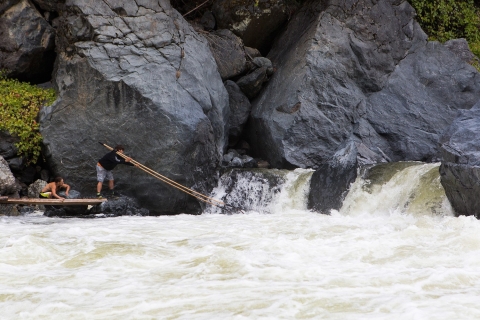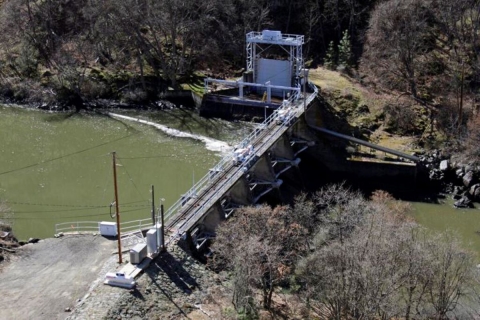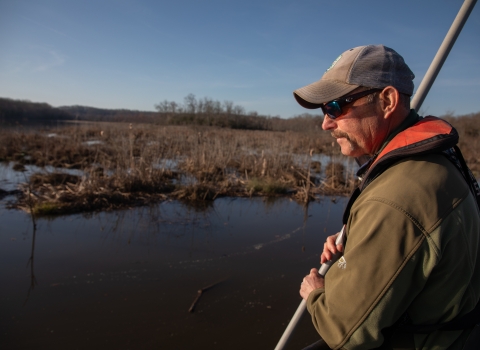Stretching from the volcanic Cascades of Southern Oregon to the Pacific Ocean in California, the Klamath River is intrinsically linked to the health of its surrounding communities, businesses, and environment. These communities include Native Americans, farmers, ranchers, loggers, miners, recreationists, and fishermen.
For thousands of years, the bounty of nature on the Klamath River served as the foundation for the health and culture of native tribes living here. The Klamath was once the third largest salmon-producing river on the West coast, teeming with what seemed to be a never-ending abundance of fish.
Long before contact, salmon runs were the common thread uniting Tribal communities throughout the Klamath River Basin. When the first salmon of the season arrived at the mouth of the Klamath in Yurok country, a runner was sent upriver to let the next village know it was time to get ready, and so on into the Upper Basin. Each community constructed fish weirs and tools for the salmon harvest. But fishing could not begin until ceremonies were performed, and enough fish had passed upstream to spawn and ensure the next generation of salmon.
Now with the dramatic effects of a changing climate making a devastating advance on our natural world, the once abundant salmon are reaching a tipping point as water quality and fish health rapidly declines.
The Yurok, Resighini Rancheria and Karuk nations and others on the Klamath once again are being forced to adapt and find a way of holding onto their culture and traditions without the fish as part of their lives.
These are their stories.
The Yurok Nation
The Yurok Nation is the largest federally recognized tribe in California, encompassing an area surrounding the lower Klamath River where it meets the Pacific Ocean in Del Norte County. The Tribal origin story is that the spirit who created Salmon (ney-puy) also created humans.
In 2014, Cal Poly Humboldt Assistant Professor Kaitlin Reed (Yurok/Hupa/Oneida) described the deep connection of salmon to the Yurok people and their identity, writing that “Salmon are a gift from the Creator. Salmon are truly the essence of Yurok existence and foundational to Yurok identity for they would not exist without them.”
“Our people are known as great fishermen,” said Yurok Tribal Chairman Joe James. “The Klamath and Trinity Rivers are the lifeline of our people because the majority of the food supply, like ney-puy are offered to us from these rivers.”
For the Yurok, hope is hard when it comes to the future of the fish they have relied on forever. There is an understanding of what the salmon are going through as many in the Tribe also feel like they are on the edge from lack of water quality and quantity that keep the salmon alive.
Many Yurok people believe that losing the salmon means losing their culture, and ultimately themselves. Being in the river, catching fish with their families, learning from elders, or passing on those traditions gives them purpose.
“When we can't be in our river, can't eat our fish, it kind of takes our purpose away,” said Annelia Hillman, Yurok Tribe member. “I think our high suicide rate is directly tied to our lack of salmon and the inability to continue our way of life.”
In 2019, the importance of keeping these fish in their culture resulted in the Yurok Tribal Council voting that the river had the same legal rights as a person. Specifically, they established “the Rights of the Klamath River to exist, flourish, and naturally evolve; to have a clean and healthy environment free from pollutants; to have a stable climate free from human-caused climate change climate change
Climate change includes both global warming driven by human-induced emissions of greenhouse gases and the resulting large-scale shifts in weather patterns. Though there have been previous periods of climatic change, since the mid-20th century humans have had an unprecedented impact on Earth's climate system and caused change on a global scale.
Learn more about climate change impacts; and to be free from contamination by genetically engineered organisms.”
To help the river and the salmon survive the effects of climate change and other impacts, the Yurok are implementing several major restoration projects that include natural resources protection, sustainable economic development, and land acquisition. Research and on-the-ground projects will study and improve salmon ecology, habitat and water quality, sustainable land use practices as well as support the historic Klamath dam removal project.
“If the salmon don’t survive, we don’t either,” said James.
The Resighini Rancheria
The Resighini Rancheria is a federally recognized Tribe of Yurok people whose land base is at the head of the Klamath River estuary. The people of the Resighini Rancheria live on the lands of their ancestors. Their identity and cultural life are inextricably tied to this place.
Their way of life historically centered on surviving from what the earth provided. Each village had its own geographical boundaries with traditional ownership to certain places, such as fishing holes, mussel rocks, and acorn gathering areas.
Tribal members continue to engage in the traditions of storytelling, gathering seaweed, mussels and resources for basket making, and to a lesser extent these days, subsistence fishing for salmon in the Klamath River.
Fawn Murphy, Tribal Chairwoman, recalled how many in the Tribe noticed environmental changes decades ago that began impacting their way of life.
“We knew things were off balance and heading in the wrong direction before we ever heard of ‘climate change;’ the water is not as clear or cold and the seasons are changing drastically,” said Murphy.
For the Resighini Rancheria, nepuey (salmon) is everything – it provides sustenance their people have relied on since time immemorial. They consider it as important as water and air.
“Salmon is what we feed our people at our funerals, weddings, births and our annual celebrations. But we haven’t been able to harvest fish in a while,” Murphy said.
In the past decade, salmon runs have declined to the point where Tribal members are no longer able to offer them to their elders or support their cultural traditions.
“We are literally starving for salmon. Our diets have changed from the lack of fish which has affected our health,” said Spa-Ghe Dowd, Tribal Council Secretary. “Our elders were used to having fish almost daily on their tables. Now many of our younger members and even our youth are getting sick. We are paying the price (for lack of salmon) with our health.”
Still, there is hope. With the recent influx of funds from the federal government, Resighini Rancheria Executive Director Megan Rocha said the Tribe is looking towards the future with improvement projects that include cleaning up non-point source pollution and restoring salmon spawning and rearing habitat on tributaries to the lower Klamath River.
“A lot of our hope today is that people all along the river will do the right thing to restore these fisheries so important to all of us,” said Rocha.
When asked about the future of the Tribes’ culture, Dowd agreed - to a point. “Hope is hard; I wish more than I hope.”
The Karuk Tribe
The Karuk Tribe is the second largest in California and are located along the mid-Klamath River in western Siskiyou and northeastern Humboldt County.
They are known as áama (salmon) and acorn people and their lives literally depended on these resources that have been a staple of Karuk culture, diet and economy for millennia.
Russell ‘Buster’ Attebery, Karuk Tribal Chairman, recalled what it was like growing up on the Klamath River with abundant fish and wildlife resources to support his people.
“In my dads’ and now my lifetime there has been a definite change in the seasons,” said Attebery. “Climate change is one of the factors that have impacted the salmon with shorter winters and drier summers.”
Attebery feels it’s a combination of climate change and humans having the greatest impact on the Karuk fisheries. He says their culture and way of life has been altered over generations by not having the salmon to put on their tables, share with the elders, or conduct the traditional ceremonies.
“My family had fish on our table at least four times a week. For me, fishing was a rite of passage to becoming a man that I learned from my dad. We only fished for enough to give to the elders and for our family. That no longer happens.”
Bill Tripp, director of the Karuk Department of Natural Resources tells of the importance of fishing traditions passed down by the elders and how a changing environment began to impact their way of life.
“The knowledge of climate change has been around for a long time. My great-grandmother warned me early on, before I was eight years old, that this was going to be a factor in my lifetime,” Tripp said. “She told me how we should be entering the next ice age...but with all the things humans have done, she didn’t know how the natural processes would be affected. There was no frame of reference in our Tribal culture for what is happening now.”
According to Tripp, before the construction of dams on the Klamath River, spring Chinook salmon may have comprised the largest salmon run on the river. As this distinct run rapidly declines, the Karuk Tribe continues its quest to ensure the survival of these fish by undertaking habitat restoration and water quality monitoring efforts.
“What gives me hope now is the dams are finally coming out, but we’re not celebrating until it starts to happen. People thought it was impossible for many years but now it will put us on a path that helps keep species like the salmon on this planet,” said Tripp.
The future of the Klamath River Basin salmon and Tribes
While these stories have a common thread in how cultures have been affected by loss of salmon, the Tribes of the lower Klamath River remain hopeful. Beginning this year, with the deconstruction and removal of the first of four dams, the lower Klamath River is one step closer to returning to a more natural state.
The project, the largest of its kind in American history, will open about 400 miles of historic salmon habitat blocked by the dams for over a century and will greatly improve water quality in the lower Klamath River basin for future generations of people and fish to thrive.
The salmon will be able to return home, and the Yurok, Resighini Rancheria, and Karuk are ready to welcome them.
*********************************************************************************************************************************
The Alaska, Pacific, and Pacific Southwest Regions of the U.S. Fish and Wildlife Service have collaborated to tell stories of climate-related challenges, adaptations, and outlook for hope for Pacific salmon species from multiple perspectives. Learn more about the efforts of the Service, Tribes and other partners to help Pacific salmon overcome the challenges they face due to climate change in this storymap.








